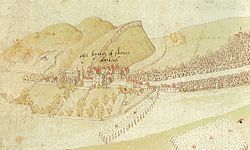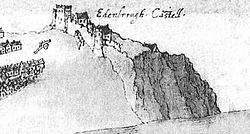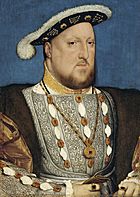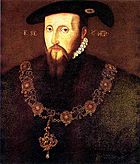Burning of Edinburgh facts for kids
Quick facts for kids Burning of Edinburgh |
|||||||
|---|---|---|---|---|---|---|---|
| Part of the Rough Wooing | |||||||
|
|||||||
| Belligerents | |||||||
| Commanders and leaders | |||||||
James Hamilton of Stenhouse, Captain of Edinburgh Castle Adam Otterburn, Provost of Edinburgh |
Lord Hertford Earl of Shrewsbury Viscount Lisle, Lord Admiral |
||||||
| Strength | |||||||
| approx 6000 horsemen with infantry (not engaged) | 200 troop-ships 12,000 infantry 4000 border horsemen |
||||||
| Casualties and losses | |||||||
| more than 400 | 40 | ||||||
The Burning of Edinburgh in 1544 was a major event during a war known as the Rough Wooing. This war was fought between England and Scotland. An English army arrived by sea and landed near Edinburgh. The Scottish army watched them land but did not fight them.
The leader of Edinburgh, called the Provost, had to let the English army take over the nearby port of Leith and then Edinburgh itself. The city was set on fire on May 7th. However, Edinburgh Castle was well-defended with cannons, and the English couldn't capture it. The English ships then sailed away, taking many stolen goods and two ships that belonged to the Scottish King, James V of Scotland.
Why the English Attacked
King Henry VIII of England wanted to unite Scotland and England. He had arranged for Mary, Queen of Scots, who was very young, to marry his son, Prince Edward. But the Scottish leader, Regent Arran, cancelled this marriage agreement. This made Henry VIII declare war in December 1543.
Some Scottish nobles still supported the marriage plan. They secretly wrote to Henry VIII, asking him to send an army. In March 1544, Henry VIII replied that a large army was getting ready. His instructions for the army were very clear: they were to "burn Edinburgh" and leave it in ruins. This was meant to be a lasting reminder of England's anger.
The English army was led by Lord Hertford. He thought about leaving English soldiers in Leith and fortifying a nearby island, but the King's advisors said no. Henry VIII also wanted him to destroy St Andrews, but Hertford said it was too far.
Hertford also discussed capturing Cardinal Beaton, a powerful Scottish church leader. Beaton was against the marriage and supported Scotland's alliance with France. Some Scots offered to capture the Cardinal, but there wasn't enough time to help them. Henry VIII was also busy planning to attack a city in France called Boulogne. So, the main goal became just to attack Edinburgh.
Getting Ready for Battle
The English army gathered in northern England. In April 1544, Sir Christopher Morris prepared many weapons and supplies for the invasion. These included cannons, bows and arrows, and long spears.
Food was also prepared. Edward Shelley, who was in charge of supplies, had a lot of biscuits ready. He faced challenges getting enough fuel for baking and brewing. About 4,000 horsemen from the English border waited for Hertford's signal. Their commander, Ralph Eure, said his men were poor and needed money. He also asked for more archers to help.
Orders for the Ships
Orders for the English fleet were given on April 28th. All ships had to be ready to sail when the wind was right. The main ship of the Lord Admiral, Viscount Lisle, would fly a special flag. Other ships had specific signals for day and night. Ships carrying heavy cannons had to place them at the front for landing.
The fleet was divided into three groups: the vanguard (front), the battle group (middle), and the rear-ward (back). Each group had several ships, including large warships like the Pauncy and the Great Galley.
Scotland's Defenses
On April 23rd, 1544, all Scottish towns along the east coast were told to build defenses against the English navy. Men from nearby areas were called to gather in Edinburgh by May 5th. More gunners were hired for Edinburgh Castle. Regent Arran's valuable belongings and the royal tapestries were moved from Holyroodhouse up to the Castle for safety.
An Edinburgh merchant was paid to find out what the English were planning. Unfortunately, most of the city's records for that year are missing. So, we don't know much about the specific defenses the town put in place. However, English reports mentioned that the Scots had dug large trenches and ditches to protect Leith.
The English Landing
The English fleet was seen before noon on Saturday, May 3rd. John Knox, a Scottish historian, wrote that Cardinal Beaton didn't think it was a big threat and calmly ate dinner. By 6 PM, there were 200 ships, and an English pilot was checking the water depth near Leith. Even though experts could see the English planned to land, the Scots did not react.
At dawn on Sunday, smaller English boats landed at Granton Crags. Troops used these boats as small piers to get off the larger ships. According to Knox, about 10,000 English soldiers landed without anyone stopping them. After this, Cardinal Beaton and Regent Arran left Edinburgh.
The English account is similar. It mentions that 5,000 to 6,000 Scottish horsemen and some foot soldiers were positioned to block the path from Granton to Leith. Cardinal Beaton was with this Scottish army. After a short fight with few casualties, the Scots left their position, leaving behind their cannons. The English commander, Hertford, described this as a quick fight.
Another small fight happened just before Leith itself. It ended after three skilled Scottish gunners were killed by arrows. Hertford then called for Ralph Eure and his border horsemen to join him. The English entered Leith without further opposition. There, they found two ships that had belonged to King James V: the Salamander of Leith and the Unicorn. Some buildings in Leith were burned, including St Ninian's chapel.
The next day, Monday, May 5th, the larger English ships unloaded heavy cannons onto the docks at Leith. These cannons were meant to be used against Edinburgh's gates and the castle. Cardinal Beaton left the area that day.
Some Scottish nobles, like the Earl of Angus and Lord Maxwell, were in prison because they supported the English marriage. Regent Arran and Cardinal Beaton ordered their release, hoping their supporters would help defend Scotland.
The Attack on Edinburgh

On May 6th, 1,500 English soldiers stayed in Leith while the main army marched towards Edinburgh. They met the Provost of Edinburgh, Adam Otterburn, who offered to give up the city's keys if certain conditions were met. Hertford refused to negotiate. Another English messenger went to the Castle and reported that 2,000 Scottish horsemen had arrived to defend the town.
Sir Christopher Morris was ordered to bring his cannons up the Canongate to attack Edinburgh's Netherbow Gate. Some English gunners were killed during this. English soldiers attacked the gate and pulled one of the Scottish cannons through its opening. The Scots couldn't fight back well because of heavy gunfire and arrows. After a few shots, the gate was broken, and the English army rushed in, killing many defenders.
On the High Street, the main street of Edinburgh, the English were exposed to cannons from the Castle. They tried to set up their own cannons, but a shot from the Castle broke one of them. At the end of that day, the English set many fires and then returned to their camp in Leith.
On May 7th, the burning and stealing continued in Edinburgh and at Holyrood Palace. Ralph Eure's 4,000 border horsemen joined the English force. Lord Hertford and his men watched Edinburgh burn from a nearby hill. They could hear "women and poor miserable creatures" crying out and blaming Cardinal Beaton.
An English captain, Nicholas Poyntz, was sent to burn villages in Fife. The fortress on Inchgarvie island was captured and destroyed. Hertford had thought about leaving soldiers at Inchgarvie, but his orders from Henry VIII didn't allow it.
The English loaded their larger cannons onto ships. On May 14th, the harbor and piers of Leith were destroyed. Hertford knighted 58 of his captains. The army left Leith by land on May 15th, burning Seton Palace and Haddington on their way.
Edinburgh Castle's Defense

Even though Hertford's army entered Edinburgh easily, the defenders of Edinburgh Castle, led by James Hamilton of Stenhouse, kept firing cannons down the Royal Mile. The English engineers, Richard Lee and William Burgate, said the castle was impossible to capture.
One of the Castle's gunners, Andrew Mansioun, was a French craftsman. His hand was injured when a cannon backfired. He was paid for his treatment in June 1544.
Repairs were made to the castle in July 1544. Gunners improved the cannon positions. The front wall of the castle was also made stronger and repaired. This work continued until August 1546.
What Was Stolen
Hertford estimated the value of goods in Leith at £10,000. This included a lot of linen cloth. The English ships were filled with property taken from Edinburgh and Leith. They also took the Salamander and Unicorn ships, loading them with 80,000 cannonballs as weight from the King's arsenal.
One item that survived being stolen is the Dunkeld Lectern. It was taken from Holyrood Abbey before the English soldiers burned the church. The lectern might have been taken by Sir Richard Lee, who drew maps of Edinburgh and Leith. Lee also took a brass font from Holyrood and gave it to St Albans Abbey in England. He had it engraved, claiming it was used to baptize Scottish Kings. This font was later destroyed during the English Civil War.
A handwritten copy of a Scottish history book, Chronicle of Scotland, was taken from Holyrood Palace by John Thynne, Hertford's steward, on May 7th, 1544.
Some of Hertford's army lists still exist. They show names of captains and where they came from. For example, Hugh Chomley traveled 130 miles with 100 men. It's believed that some carved wood panels at Speke Hall in England came from Holyrood Palace, though this is debated. Books found at Speke Hall were marked by William Norris, saying they were "won at Edinburgh on 8 May 1544." These books were returned to Scotland in 2008. They had belonged to the Abbot of Cambuskenneth, a Scottish church leader.
Places That Were Burned
The English army burned many towns and villages on their way back. A writer named Walter Lynne described the destruction, saying they spared "neither castle, town, pile nor village."
Here are some of the places that were burned or destroyed:
- Craigmillar Castle and village, May 12th.
- Prestonpans and Preston Tower, May 12th.
- Newbattle Abbey, May 15th.
- Part of Musselburgh and the Chapel of Loretto, May 15th.
- Dunbar, May 18th.
- Seton Palace, May 16th.
- Tranent, May 16th.
- Haddington town, Friary, and Nunnery, May 17th.
- Markle Castle, May 17th.
- East Linton, May 17th.
The English fleet also burned places along the coast, including Kinghorn, St Monans, South Queensferry, and Burntisland.
What Happened Next
News of the burning spread quickly across Europe. However, despite the physical damage, a historian named Marcus Merriman said that the attack "really did little of any long-term effect." Edinburgh was not attacked again in that war, but rebuilding was slow. New buildings were often built exactly where the old ones stood.
At the end of the war, in 1551 and 1552, the Scottish Parliament set rules for how people would share the costs of rebuilding the homes and lands that were "burnt by the old enemies of England."
Hertford's Knights
Lord Hertford, as the King's representative, knighted many of his captains. Their names are recorded in old pay-books. These lists show where the captains came from.
Knighted on Sunday, May 11th, at Leith:
- Edward Clinton
- John Conyers
- John Luttrell
- Richard Lee
- Thomas Cokayne
- Peter Mewtas
Knighted on Tuesday, May 13th, at Leith:
- Charles Howard
- George Blount
Knighted on Sunday, May 18th, near Coldingham:
- William Damport
- Ralph Leycester
- John Nevill
- Hugh Willoughby
- Robert Constable
|
See also
 In Spanish: Incendio de Edimburgo para niños
In Spanish: Incendio de Edimburgo para niños





